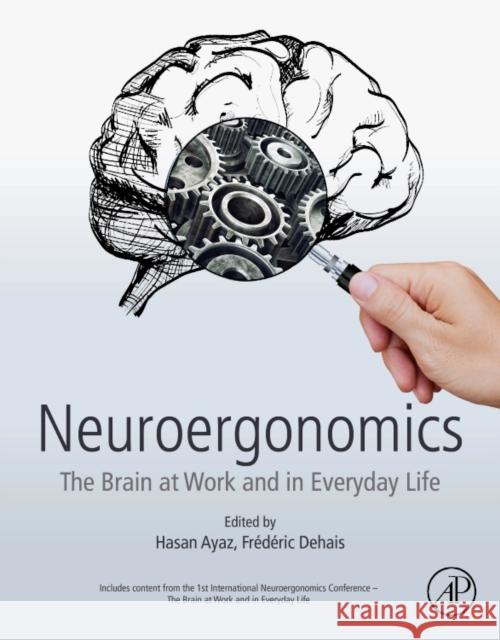Neuroergonomics: The Brain at Work and in Everyday Life » książka



Neuroergonomics: The Brain at Work and in Everyday Life
ISBN-13: 9780128119266 / Angielski / Miękka / 2018 / 366 str.
Neuroergonomics: The Brain at Work and in Everyday Life
ISBN-13: 9780128119266 / Angielski / Miękka / 2018 / 366 str.
(netto: 366,01 VAT: 5%)
Najniższa cena z 30 dni: 381,16
ok. 30 dni roboczych
Bez gwarancji dostawy przed świętami
Darmowa dostawa!
Wydanie ilustrowane
Introduction 1. Progress and Direction in Neuroergonomics
Methods 2. Electroencephelography for Neuroergonomics 3. Functional Near Infrared Spectroscopy for Neuroergonomics 4. Why is eye-tracking an essential part of Neuroergonomics? 5. The use of tDCS and rTMS methods in Neuroergonomics 6. Brain Computer Interfaces for Neuroergonomics 7. Transcranial Doppler Sonography for Neuroergonomics 8. Simulators and Behavioral Research Methods for Neuroergonomics 9. Neuroergonomics for Aviation 10. MoBI - Mobile Brain Body Imaging 11. Experiments with participants: Some ethical considerations
Neuroadaptive Interfaces and Operator Assessment 12. Measuring the Redline for Mental Overload Using EEG and fNIRS: A Role for Neural Efficiency? 13. Drowsiness Detection during Driving Task Using fNIRS 14. Neuroergonomic Multimodal Neuroimaging During a Simulated Aviation Pursuit Task 15. Is Mindfulness Helping the Brain to Drive? 16. Tracking Team Mental Workload by Multimodal Measurements in The Operating Room 17. Towards Brain-Based Interaction Between Humans and Technology: Does Age Matter? 18. Curvilinear Basis for Cognitive Load State Classification 19. Computational Models for Near Real-Time Performance Predictions Based on Physiological Measures of Workload 20. Mental Workload Assessment as Taxonomic Tool for Neuroergonomics 21. Preliminary Validation of an Adaptive Tactical Training Model: Cognitive Alignment with Performance Targeted Training Intervention Model
Neurostimulation Applications 22. Concurrent fNIRS and TMS for Neurocognitive Enhancement on a Speed of Processing Task 23. Neuromodulatory Effects of Transcranial Direct Current Stimulation Revealed by Functional Magnetic Resonance Imaging 24. Neurophysiological Correlates of tDCS-induced Modulation of Cortical Sensorimotor Networks: A Simultaneous fNIRS-EEG study 25. The use of Online/Offline Terminology for Transcranial Direct Current
Emerging Applications in Decision-making, Usability, Trust and Emotions 26. Neural Signatures of Advice Utilization During Human-Machine Agent Interactions: Functional Magnetic Resonance Imaging and Effective Connectivity Evidence 27. Psychophysical Equivalence of Static Versus Dynamic Stimuli in a Two Alternative Forced Choice Detection Task 28. Functional Near Infrared Spectroscopy: Proof of Concept for its Application in Social Neuroscience 29. Quantifying Brain Hemodynamics during Neuromuscular Fatigue 30. The Assessment of Emotions and Decision Making in Everyday Living Using fNIRS 31. Web Usability Testing with Concurrent fNIRS and Eye Tracking 32. Hybrid Collaborative Brain-Computer Interfaces to Augment Group Decision Making 33. How to Recognize Emotion Without Signal Processing: An Application of Convolutional Neural Network to Physiological Signals
Entries from the Inaugural International Neuroergonomics Conference
Dr. Ayaz is an Associate Professor of Biomedical Engineering at Drexel University, School of Biomedical Engineering, Science and Health Systems with adjunct affiliations at the University of Pennsylvania and Children's Hospital of Philadelphia. He also serves as a core member of the Cognitive Neuroengineering and Quantitative Experimental Research (CoNQuER) Collaborative.
Dr. Ayaz's research focuses on understanding the neural mechanisms underlying human cognitive and motor functioning with emphasis on real-world contexts, mobile neuroimaging, and neuroengineering approaches for neuroergonomics applications. His research aims to design, develop, and utilize (i.e. to measure->elucidate->enable) next-generation brain imaging for neuroergonomic applications over a broad-spectrum from aerospace to healthcare. His research has been funded by federal agencies, corporate partners and foundations, and output over 200 publications in international journals and conferences.
For over 17 years, he worked on the development of miniaturized optical brain monitoring systems focusing on imaging in natural environments and everyday settings. He has designed and developed multiple continuous-wave near infra-red spectroscopy instruments that are now in routine use for clinical and field research in hundreds of university, governmental and corporate research labs. As an extension to this, he led the software design and development of the first handheld optical-brain-monitoring medical device, Infrascanner, that received de novo FDA approval, utilizes near-infrared light to detect hematoma in head trauma patients, tested with 12 independent clinical studies with over 1,200 patients and currently deployed in 42 countries/6 continents in both civilian and military hospitals, already became the standard of care for children and sports medicine in some European countries.
Dr. Dehais is a full professor at the Institut Supérieur de l'Aéronautique et de l'Espace (France) and holder of the AXA Chair in Neuroergonomics for Flight Safety, a rare credit attributed to less than thirty researchers in the world. He is leading the Neuroergonomics and Human Factors Department, a team composed of 18 members with an interdisciplinary expertise in Neuroscience, Signal Processing, Computer Science, and Human Factors. His research focuses on understanding the neural correlates of human error in real-life situations and the implementation of BCI and cognitive countermeasures to mitigate human error. His department receives substantial grants from European, National funds as well as Industry and his research led to more than 120 publications in international journals anc conferences. His innovative work has also led to five international patents. He has co-organized several national and international conferences such as HFES Europe 2012. He is also the co-founder of the European 2fNIRS portable brain imaging conference with Prof. S. Perrey and co-chair of the International Neuroergonomics conference with Dr. Hasan Ayaz.
1997-2025 DolnySlask.com Agencja Internetowa
KrainaKsiazek.PL - Księgarnia Internetowa









